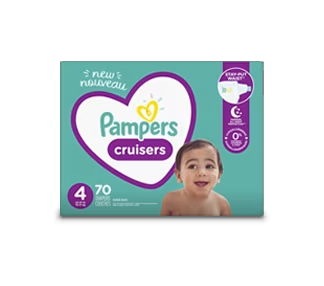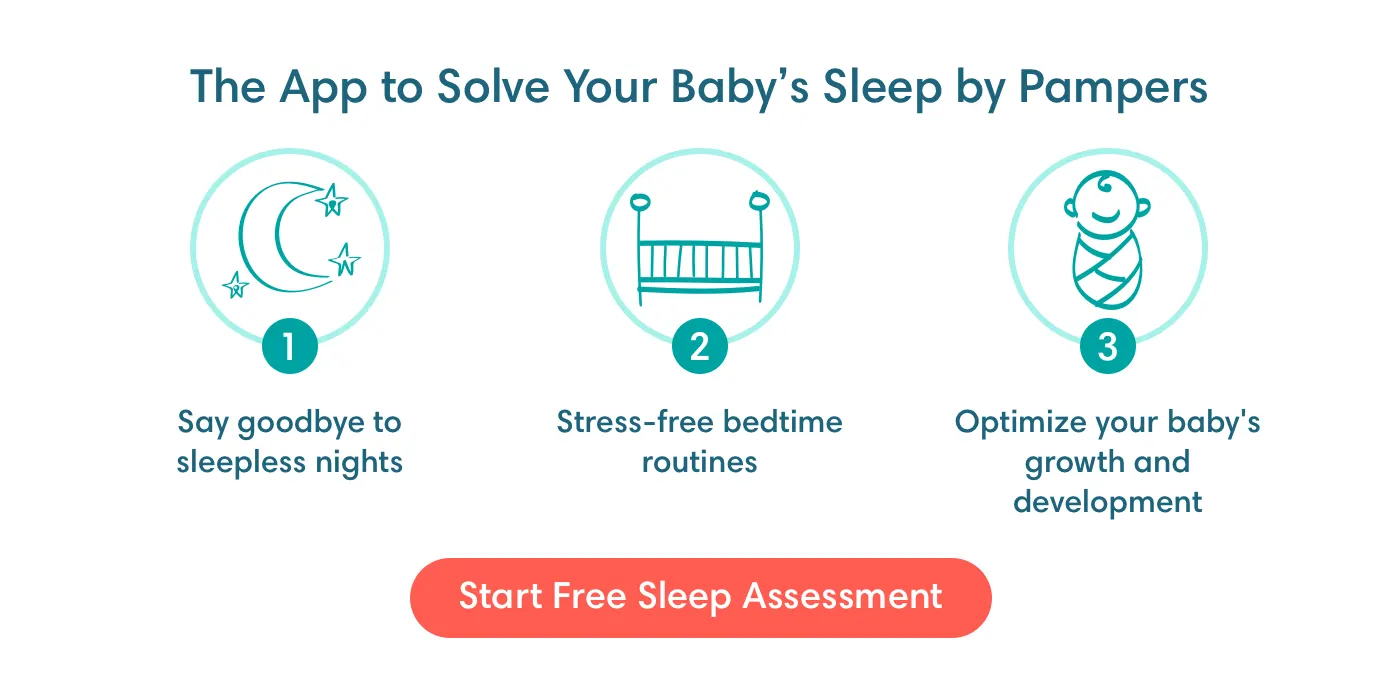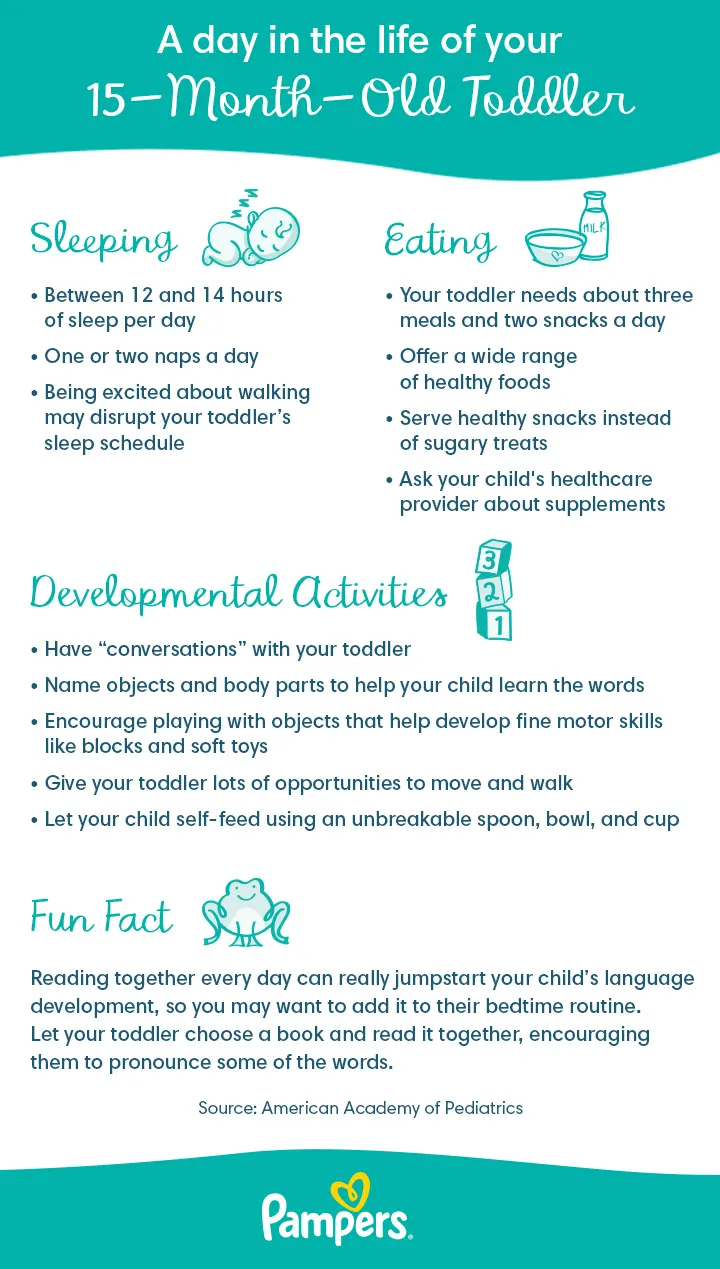15-Month-Old: Your Independent Toddler
Most likely, your 15-month-old baby is reaching some new and exciting milestones, such as becoming more confident at walking. At 15 months old, toddlers also tend to experiment with other types of movements and, little by little, reveal their temperaments and personalities. Keep reading to learn more about what developments and milestones to anticipate with your growing 15-month-old baby!
Toddler Development: 15-Month-Old Milestones
As every child is unique, the timing of development milestones and the way they are achieved may be different from one baby to another. Remember that every child progresses at their own pace, so try to be patient if some milestones are reached a little later than others. Here are examples of some of the milestones you may see with your 15-month-old this month:
Slower growth. During this second year, your toddler’s rate of growth may be slower compared with how quickly they grew in their first 12 months. You may notice that your 15-month-old’s height and weight increase at a slower and steadier rate, and their head circumference growth may also slow down around this time. Your baby’s healthcare provider will continue to track their growth at regular checkups using the growth chart you may be familiar with from previous visits.
Climbing attempts. If your child has been walking for a while, they’ve likely gotten quite good at it, and might be ready for a new challenge—the stairs. Climbing up is the first stage of the process, and your little one will be eager to practice, with you closely watching. Coming down is harder, and you may need to help position your baby to do this safely going backwards. (Make sure you keep the stairs gated to prevent any solo attempts!)
Temperament on display. Your 15-month-old’s temperament is something that is individual to them, and it can’t be changed. As a parent, you can support your child by encouraging their strengths, and being there when they feel unsure. For example, if your toddler is showing signs of separation anxiety, at certain times of the day, it may help to offer support. If it happens at bedtime, for example, consider leaving a night-light on or letting them sleep with their favorite blanket.
Understanding how objects function. As your toddler gets to know the world around them, they’ll begin to understand how certain objects function, an important step in cognitive development. You might see that they start to use some things as intended—even if not quite successfully. For example, your 15-month-old may run a hairbrush over their hair or hold a telephone to the side of their face. These moments are sure to put a smile on your face as you see your little one connect the dots.
Tip If you’re wondering whether your toddler’s development is on track, the 15-month-old checkup is a great time to talk to your baby’s healthcare provider about their individual growth and if there are any red flags to look out for. |
And as your toddler grows bigger, make sure they have the correct size diaper. Download the Pampers Club App and get rewards for all your Pampers purchases.
How to Support Your 15-Month-Old’s Milestones
Here’s how you can support and encourage your 15-month-old’s development:
Reinforce language leaps and boost vocabulary. As your toddler starts to grasp language, they may have their own made-up vocabulary. For example, you may hear something like “wa-wa” for water. Although these words are cute, it’s best to reinforce correct pronunciation while being patient with your child’s efforts. A good tip is to let your child speak and then respond with the correct pronunciation. If your 15-month-old is not talking very much, keep speaking with them. Language skills will improve over time with your help.
Offer warm physical contact. Hugs and skin-to-skin contact are more than just warm bonding moments for you and your child; they can do a lot for your toddler’s sense of security when offered on a consistent basis. Hug your 15-month-old often and spend time cuddling regularly—for example, during bedtime stories.
Play with your toddler. There are plenty of toys and activities for 15-month-old toddlers, but you’ll make it more fun if you join! Sit on the floor during playtime activities and take the opportunity to enjoy quality time together every day. You can build something together with blocks or chant a nursery rhyme that has hand gestures. Even when you're having a busy day, you might find you enjoy these sessions as much as your toddler does!
Read together every day. Reading with your toddler is just about the best way to foster language development and early literacy, and it’s also a lovely way to spend one-on-one time together. Bedtime is a particularly good time to read with your little one, as it can help get into a sleep routine. Although your 15-month-old isn’t reading quite yet, let them try to pronounce the words. Feel free to elaborate on the story and add some extra elements to make it even more fun for your little one, for example, “Look at the cat—he’s wearing a hat.”
15-Month-Old Feeding Schedule: Mealtimes and Menus
Three small meals and two snacks a day is a good feeding schedule for a 15-month-old baby. Don’t worry, though, if your toddler eats everything in sight one day while rejecting some foods or even meals the next day. It’s all a part of the process! Changes in appetite may be the natural result of things like increased activity levels, fluctuations in metabolism, and growth spurts. Don’t take it to heart if your toddler doesn’t want to eat the food you’ve prepared for them. If your 15-month-old isn’t eating their lunch, for example, save it for later when they may change their mind and gladly eat it. To ensure your child is getting all the nutrients they need, offer a variety of healthy foods at each mealtime, including:
Protein foods like meat, fish, poultry, and eggs
Dairy products like cow’s milk and yogurt
Fruits and vegetables
Grains and starches like cereal, bread, pasta, potatoes, and rice.
Tip Keep in mind that, although your little one may not consume a variety of nutritious foods on one particular day, over the course of a few days, their diet will balance out overall, and they’ll get the nutrients needed to grow and stay healthy. How cool is that?! |
15-Month-Old Baby Sleep Schedule
Sleep is important for your 15-month-old’s health and optimal development. At this age, your toddler needs about 12 to 14 hours of sleep per day, which includes one or two daytime naps.
To help ensure that your 15-month-old’s sleep schedule is providing enough rest, create a regular bedtime routine. A consistent routine may also help if your 15-month-old experiences sleep regression. Here are some guidelines:
Stick to the clock. Try to keep bedtime and naptimes the same every day. That way, your toddler is more likely to feel sleepy when the time for sleep rolls around.
Have some quiet time. Winding things down and avoiding exciting play just before bed can help your little one get ready for sleep. Story time, relaxing music, or a warm bath are all good examples of what you could do to help your child relax.
Let your toddler have a "lovey." It’s OK for your child to sleep with a stuffed animal or blankie if they find it comforting. These transitional objects can help your child fall asleep more easily and provide self-comfort if waking up during the night.
Provide a little light. You may consider having a night-light for your toddler or leaving the bedroom door slightly ajar so that the room isn’t pitch black.
Wait before responding. In the middle of the night, if your child calls for you or cries a little, you might wait for a short time before responding. Then, you might like to check that your toddler is OK and reassure them from the doorway instead of picking them up or turning on the bedroom light. If your 15-month-old experiences nightmares, night terrors, or wakes up screaming while being inconsolable, of course, address their needs.
Be patient. It takes a while for toddlers to establish good sleep habits, so it’s normal for your little one to wake up in the night from time to time. Stay encouraging, and try to avoid responding to your child’s needs in a negative way. This will help them learn that trust you to be there when truly needed—knowing this will help your baby feel more comfortable about self-soothing and falling back to sleep on their own.
A Day in the Life of Your Toddler
Here’s an idea of what a day with your 15-month-old might look like at your home:
Your Toddler’s Health and Safety: Teething and Brushing
Teething is a natural part of your toddler’s development, even if it’s not always comfortable. To help your 15-month-old with any teething discomfort, you can gently massage their gums with your finger or offer a teething ring to chew on. Sometimes, teething may accompany a low-grade fever of no more than 38 degrees Celsius. If your toddler has a fever higher than that, it’s probably not linked to teething and important to take your little one to their healthcare provider for a checkup. Continue teaching your child about good oral hygiene habits, including brushing their teeth twice a day. To help make this less of a chore for your toddler, you could
sing a song while your little one brushes
play some music on your phone
let your 15-month-old choose a fun child’s toothbrush
use a cute cup for rinsing.
Although your little one won’t be able to brush their teeth completely on their own until about 7 years old, establishing the routine early sets your child up for great lifelong habits and ensures healthy teeth and gums. Read up on how to brush your baby’s teeth.
Your Life as a 15-month-old’s Parent: Caring for a Sick Child It’s inevitable that from time to time your child may come down with a cold or some other common childhood illness. If your 15-month-old experiences symptoms like chest congestion or a fever above 38 degrees Celsius, contact their healthcare provider. Aside from the worry of caring for your sick little one, you may also have to rearrange your days while your toddler is feeling unwell. It’s a good idea to keep your child home until they’re feeling better to avoid spreading germs to the other children. Your baby’s healthcare provider will be able to advise on when they’re well enough to return to playdates or daycare. Ensure that your 15-month-old baby is up to date on their vaccines. Read more about immunizations and vaccine schedules.
Tip Caring for your sick child isn’t always easy, but don’t be afraid to ask for help and contact your baby’s healthcare provider if their condition doesn’t improve. With most common illnesses like a mild cold or a sore throat, things should resolve within a few days and life will soon get back to normal. |
FAQS AT A GLANCE
Around this month, your 15-month-old baby may be able to do things like:
- Stack toy blocks into a short tower
- Scribble or paint blotches on a page
- Crawl up or climb stairs with your help
- Say several single words.
Keep in mind that each child develops at a unique pace, and your little one may develop these skills a little earlier or later than this.
Checklist for This Month
Schedule your child’s next checkup. If you don’t already have a time set for your child’s next checkup, make an appointment soon. Before the checkup, write down any questions or concerns you may have about your child’s health, growth, or development so that you don’t forget to raise them at this appointment.
Check that your toddler is within the height and weight limits of your car seat. You may need to upgrade to a toddler car seat if your little one has outgrown your existing car seat, which means they’re no longer within the height and weight limits specified by the manufacturer. Remember that it’s important to keep the car seat in the rear-facing position until your child is 2 years old.
Acquaint your toddler with a babysitter. At some point, you may need to introduce a new babysitter to your 15-month-old, and you may want to start the search sooner rather than later. When you interview potential babysitters, keep your toddler by you or on your lap, and watch for signs that they’re comfortable with the new person. Gradually let your child and the babysitter get closer, and you may even want to leave the room for a brief moment to test your toddler’s reaction. Whomever you choose, it’s important that they have experience with young children, come with good references, know CPR, and have taken a babysitter safety course.
Take your toddler shoe shopping. As your little one gets more and more active, including walking more outside, it’s a good idea to check that their shoes fit properly. If you can, have your child’s shoe size measured at the store. Look for shoes that feature nonskid soles, like sneakers. Whatever style you choose, it's worth knowing that your 15-month-old will most likely outgrow them in a matter of months.
Go clothes shopping for the next size up. It’s also a good idea to be prepared for your toddler’s ever-changing clothing size. Take advantage of any clothing sales or clearances that may be happening this month to stock up on clothes your toddler may need in the near future. Alternatively, take some time to figure out what hand-me-downs from your older children you have in the closet so that you can take stock of what you already have. You could even organize a clothes swap with parents in your community to stock up on clothes your little one will need in the future and share the clothes your toddler no longer fits.
The information in this article is based on the expert advice found in trusted medical and government sources, such as the American Academy of Pediatrics and the American College of Obstetricians and Gynecologists. You can find a full list of sources used for this article below. The content on this page should not replace professional medical advice. Always consult medical professionals for full diagnosis and treatment.
15 month old baby - checklist







